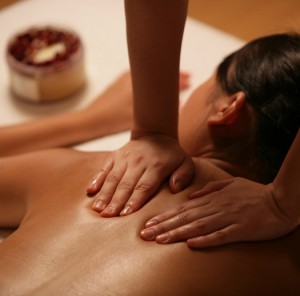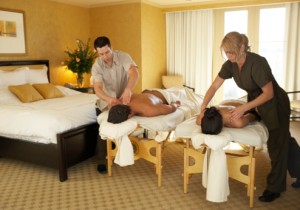 SNI: What kind of training do you need to become a licensed massage therapist?
SNI: What kind of training do you need to become a licensed massage therapist?
Debbie: Each state is different as far as what is required to be a Licensed Massage Therapist. In South Carolina, where I practice, Massage Therapists are required to have at least 500 hours of training from an accredited Massage Therapy School. They must also be Nationally Certified, pay an “Application” and “Licensing” fee, and obtain 12 hours of Continuing Education every 2 years.
SNI: What are the different types of massage?
Debbie: There are over 150 types of massage, but the 5 most popular are as follows (in no particular order):
1) Swedish – This is the most common form of massage therapy in America. Long, soothing strokes are used on the superficial layers of each muscle group. Swedish Massage is most beneficial for increasing circulation, eliminating toxins, and improving overall relaxation.
2) Deep Tissue – This treatment focuses on the deeper layers of muscle and connective tissue (fascia), and is applied with greater pressure than a Swedish Massage. This therapy aims to alleviate pain and tension in specific problem areas. Deep Tissue massage is recommended for those who are involved in extreme physical activity, have chronic pain, or are recovering from a specific physical injury.
3) Sports – Sports Massage is used to manipulate the body’s soft tissue in order to improve an athlete’s overall performance. This type of massage helps to increase flexibility and range of motion of an athlete’s joints and muscles. It also helps to speed up recovery from injury or surgery, and rid the body of any toxins in the soft tissue. This type of massage is good for all levels of athletes from “Weekend Warriors” to more elite competitors.
4) Neuromuscular – This type of therapy treats specific areas of soft tissue within the body using static pressure to relieve pain and improve the body’s overall biomechanics. In turn, balance is brought to the body’s Central Nervous System (CNS) and Musculoskeletal System. Neuromuscular Therapy (NMT) helps increase circulation to the soft tissue and restores postural alignment, strength, and flexibility of the injured tissues. NMT is most beneficial for those experiencing back pain, sciatica, migraines, numbness and tingling in extremities, and several other conditions caused by muscle hypertonicity and spasm.
5) Shiatsu – Originating in Japan, Shiatsu is a therapy that restores the flow of energy within the body. There are different energy pathways that run along the head, arms, legs, and torso called ‘meridians’. Each meridian is associated with an organ in the body. Pressure is applied along these meridians using fingers, thumbs, palms, or elbows while the client is lying on a futon, fully clothed. As the therapist works along each meridian, it releases blocked energy, allowing it to flow freely throughout the body. Shiatsu is known not only for increasing relaxation, but also for helping to strengthen the body’s immune system and relieve pain.
SNI: What are the different massage strokes and under what circumstances would you use them?
Debbie: Of the various types of massage techniques, the 5 most commonly used are:
1) Effleurage – A gentle, gliding motion where the therapist’s hands maintain constant contact with the skin. Generally this is used at the beginning and end of a massage treatment.
2) Petrissage – A technique where the pressure is deeper than that used in Effleurage. Muscles are pressed and kneaded in order to break up adhesions and increase circulation in a specific area. This is used after the soft tissue has been warmed up with Effleurage.
3) Friction – Quick, deep massage strokes are used in this technique to break up scar tissue and increase blood circulation within a focused area. This is usually done in a linear or circular pattern. Friction is best used in areas of bound up muscle fibers such as trigger points or scars.
4) Tapotement – This involves short tapping movements with alternating fingers, cupped hands, or the outer edge of both hands. This technique is good for increasing blood circulation, eliminating toxins, and stimulating muscle reflexes.
5) Compression – A technique where firm pressure is applied with fingers, palms, or fists to a specific area of soft tissue in the body. This is used in order to help relieve tension or pain in that area.
SNI: What is the biggest misconception about massage therapy?
Debbie: One of the biggest misconceptions about massage therapy is that it is still considered a “luxury” by many. When people think of ‘massage’, often times they believe it is a treatment that is simply for relaxation. A therapeutic massage actually does more than just relieve stress and tension. Massage Therapy can help increase circulation of blood and lymph, decrease pain, improve joint range of motion, and break up scar tissue, in order to aid in muscle repair and recovery. The amount of health benefits that massage offers is endless.
Another misconception by many is that one must go to a spa and pay ‘an arm and a leg’ just to receive a massage treatment. Nowadays, Massage Therapy is becoming more prevalent in healthcare facilities other than spas, and at more affordable rates as well. With the price of healthcare rising every year, it would be more cost effective for people to become proactive with their health, and incorporate alternative therapies such as Massage into their lives.
SNI: Are male or female clients easier to massage? Why?
Debbie: In my experience, female clients tend to be easier to massage than male clients. Every so often I get the occasional big, muscular guy who is crying ‘uncle’ at the slightest amount of pressure, or a little old lady who would barely notice if I used a jack hammer on her to break up the tension in her muscles. The sensitivity in the muscle tissue itself determines how much the client can tolerate when receiving a therapeutic massage. Many factors come into play such as past injuries/surgeries, certain autoimmune disorders, and muscle tissue density. No matter what the case may be, I manage to adjust the pressure to each and every client’s needs.
SNI: How often do men experience “involuntary anatomical arousal” and how do you deal with that?
Debbie: It happens very rarely, but when it does it is usually unintentional. I just ignore it and continue with the massage session. More often than not, the client is embarrassed and is hoping I am not even aware of what has happened. If the client has intentions of wanting an “inappropriate” massage I immediately end the session, require full payment, and suggest that he take his business elsewhere.
SNI: If you could be a superhero, who would it be and why?
Debbie: If I could be any superhero, I would want to be Wonder Woman. Not only does she have amazing speed, super strength, and the ability to fly, but she also has that cool ‘magic lasso’ that forces people to tell the truth. I can think of a few politicians I wouldn’t mind using that on. To be honest, I really just want to wear that fun red, white, and blue outfit of hers with the metal headband and wristbands.
SNI: Who is the most interesting client that has ever received a massage from you?
Debbie: Of all the amazing people I have worked with throughout my 10-year career, the most interesting would have to be a retired gentleman I met back in 2008. A few years before we met, he had undergone ‘routine’ surgery where he had acquired Sepsis (an infection in the bloodstream). As a result, his body began to shut down and he fell into a coma for 72 days. Within that time, he was pronounced dead on 3 separate occasions and miraculously came back to life each time. When I met my client, he had had ½ of his organs removed, was suffering from neuropathy in his legs, and was only able to walk with the use of a walker. After 4 years of massage and strong mental determination, he is to the point where he can walk on his own again and is able to play 18 holes of golf once or twice a week. Talk about a “Miracle”!
BIO – Debbie Lipski, LMT, NCMT is a Licensed and Nationally Certified Massage Therapist. She received her B.A. in Psychology in 1999 from Indiana University where she competed in Platform and Springboard Diving. In 2001, she graduated from the Boulder College of Massage Therapy where she has done extensive studies in Sports and Orthopedic Massage. Debbie has worked directly with numerous professional athletes including the Colorado Rapids Pro Soccer Team, Monica Seles, and several Nationally ranked, Olympic and World Champion cyclists. Currently, Debbie has her own Massage Therapy practice in Columbia, SC specializing in Deep Tissue, Sports Massage, and Injury Rehabilitation. Debbie is a NPC National Level Figure Competitor, Fitness Model, and part-time Soigneur for various professional road cycling teams.



